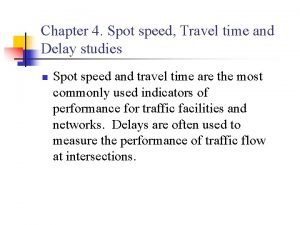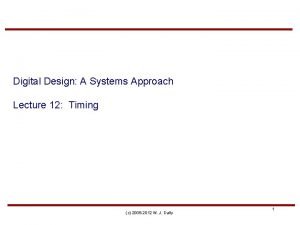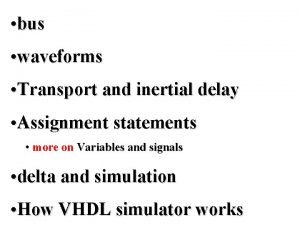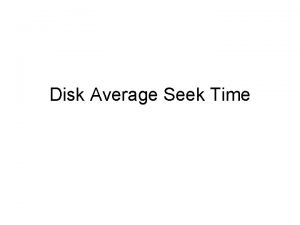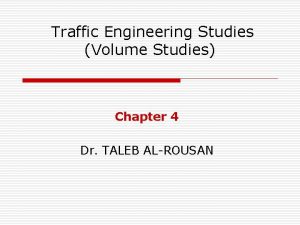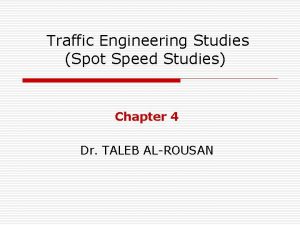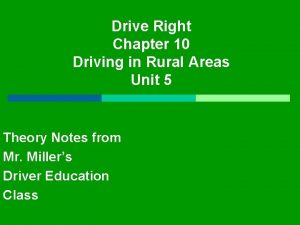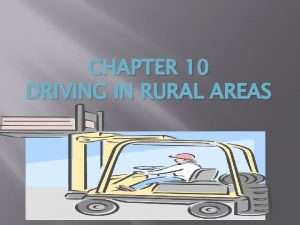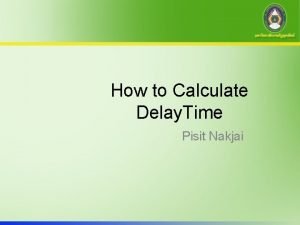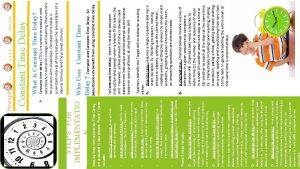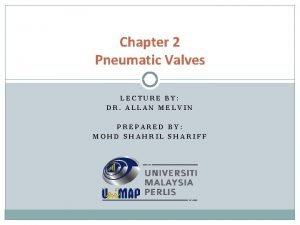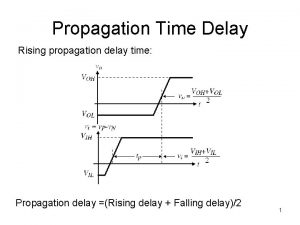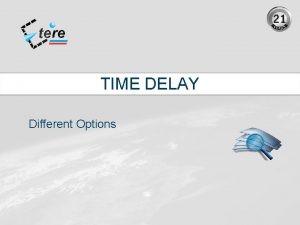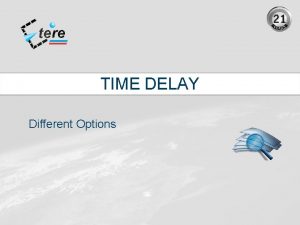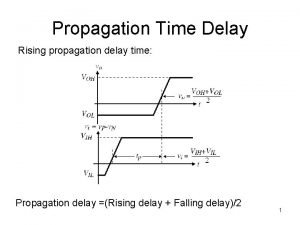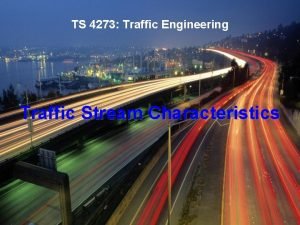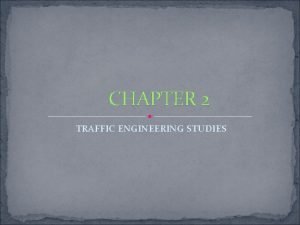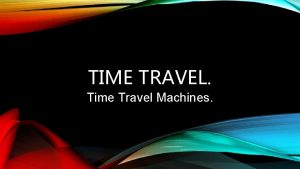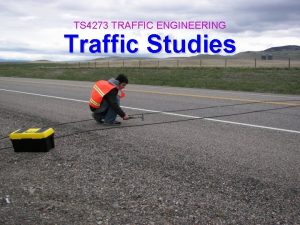Traffic Engineering Studies Travel Time Delay Studies Chapter






![Methods requiring a test vehicle Floating-Car Technique N = [(ta x s )/ d]2 Methods requiring a test vehicle Floating-Car Technique N = [(ta x s )/ d]2](https://slidetodoc.com/presentation_image_h2/dea4c71eb97025f3b0571fe97a648a21/image-7.jpg)







- Slides: 14

Traffic Engineering Studies (Travel Time & Delay Studies) Chapter 4 Dr. TALEB AL-ROUSAN

Introduction o o o Travel time study determines the amount of time required to travel from one point to another on a given route. In conducting such studies information on locations, durations, and causes of delay mabe be collected. When this is done the study is known as a travel time and delay study. The data obtained give a good indication of the level of service on the study section The data also aid traffic engineers in identifying problem locations which may require special attention in order to improve the overall flow of traffic on the route.

Application of Travel Time & Delay Data o The data obtained in these studies can be used in any one of the following traffic engineering tasks: n n n Determination of the efficiency of a route with respect to its ability to carry traffic. Identification of locations with high delays and the cause of those delays. performance of before and after studies to evaluate the effectiveness of traffic operation improvements. Determination of relative efficiency of a route by developing sufficiency ratings or congestion indices. Determination of travel times on specific links for use in trip assignment models. Performance of economic studies in the evaluation of traffic operation alternatives that reduce travel time.

Terms Related to Travel Time & Delay Studies o o o o Travel Time: Is the time taken by a vehicle to traverse a given section of a highway. Running Time: Is the time a vehicle is actually in motion while traversing a given section. Delay: Is the time lost by a vehicle due to causes beyond the control of the driver. Operational Delay: Is that part of the delay caused by impedance of other traffic. (impedance as side friction (e. g. parking vehicle) or as internal friction (e. g. capacity reduction of highway)). Stopped-Time Delay: Is the part of the delay during which the vehicle is at rest. Fixed Delay: Is the part of the delay caused by control devices such as traffic signals. Travel-Time Delay: Is the difference between the actual travel time and the travel time that will be obtained by assuming that a vehicle traverses the study section at an average speed equal to that of an uncontested traffic flow on the study section.

Methods of Conducting Travel Time & Delay Studies o o o Two general categories: n Methods using test vehicle. n Methods not requiring a test vehicle. n The selection of the method depends on the reason of conducting the study and the available personnel and equipment. Methods requiring a test vehicle: n Floating-car Technique n Average-Speed Technique. n Moving-vehicle Technique. Methods not requiring a test vehicle: n License-Plate Observations. n Interviews.

Methods requiring a test vehicle Floating-Car Technique o o o The test car is driven by an observer along the test section so that the test car “floats” with traffic. The test vehicle attempts to pass as many vehicles as those that pass his test vehicle. The time taken to traverse the study section is recorded. The procedure repeated and the average time is recorded as the travel time. Minimum number of test runs N = [(ta x s )/ d]2
![Methods requiring a test vehicle FloatingCar Technique N ta x s d2 Methods requiring a test vehicle Floating-Car Technique N = [(ta x s )/ d]2](https://slidetodoc.com/presentation_image_h2/dea4c71eb97025f3b0571fe97a648a21/image-7.jpg)
Methods requiring a test vehicle Floating-Car Technique N = [(ta x s )/ d]2 N= sample size (min. number of test runs). s = standard deviation (mi/h) ta = value of the student t-dist. With (1 -a/2) confidence level and (N-1) degrees of freedom a : significance level. d : limit of acceptable error o The sample size is usually less than (30) which makes the t-dist. Is more appropriate than the Z values. o d= ± 1. 0 to ± 3. o mi/l for before & after studies o d= ± 2. 0 to ± 4. o mi/l for traffic operations, economic evaluation, and trend analysis studies o d= ± 3 to ± 5. o mi/l for Highway needs and planning studies.

Methods requiring a test vehicle Average-Speed Technique o o o Involves driving the test car along a length of the test section at a speed that, in the opinion of the driver, is the average speed of the traffic stream. The time required to traverse the test section is noted Test is repeated for min. number of times, and the average time is recorded at the travel time. In both floating-car and average-speed methods the travel time is usually obtained by observer who starts a stop watch at the beginning point and stops it at the end of the section. Another stop watch may be used to measure stops times which are summed to find the stopped-time delay. Alternatively, this can be done using a laptop with internal clock and distance function. The data are recorded automatically and the cause of delay are then recorded by the driver on a tape recorder.


Methods Requiring A Test Vehicle Moving-Vehicle Technique o o Observer makes a round trip on a test section starting from section (X-X) to (Y-Y) (East direction) then returns back from (Y-Y) to (X-X) West direction. The observer records during the round trip the following: n The time it takes to travel from (X-X) to (Y-Y) East in minutes (Te). n The time it takes to travel from (Y-Y) to (X-X) West in minutes (Tw). n The number of vehicles traveling in the opposite direction while the test vehicle is traveling from (X-X) to (Y-Y) east (Ne) n The number of vehicles that over take the test car while it is traveling from (Y-Y) to (X-X) West (Ow). n The number of vehicles that the test car passes while it is traveling from (Y-Y) to (X-X) West (Pw).


Methods requiring a test vehicle Moving-Vehicle Technique o The volume in the (Y-Y) to (X-X) Westbound direction (Vw) cab be obtained by: Vw = [(Ne + Ow –Pw)*60. / (Te + Tw)] o o (Ne + Ow –Pw) is the number of vehicles traveling westward that cross the line (X-X) during the time (Te + Tw). The average travel time in the west direction is given by: Ťw = Tw – [(60 (Ow – Pw))/ Vw)] o o o It the test car travels at average speed it is most likely that number of vehicles it passes will equal the number of vehicles that over take it. But it is more probable that the test car will not be traveling at the average speed, thus the second term in the equation is provided to correct for the difference between the number of vehicles that overtake the test car and the number of vehicles that are overtaken by the test car. See Example 4. 6.

Methods not requiring a test vehicle/ License-Plate Observations o o o Requires that the observers be positioned at the beginning and end of the test section. Each observer records : n The last three or four digits of the license plate of each car that passes. n Time at which the car passes. Matching of times of arrival at the beginning and end of the test section for each license plate is made in the office. The difference between these times is the traveling time of each vehicle. The average of these times is the average traveling time on the section. Sample size of 50 matched license plate will give reasonably accurate results.

Methods not requiring a test vehicle/ Interviews o o o Carried out by obtaining information from people who drive on the study site regarding their travel times, their experience of delays, and so forth. This method facilitates collecting large amount of data in relatively short times. Requires cooperation of the people contacted.
 Travel time and delay studies
Travel time and delay studies Parking accumulation curve
Parking accumulation curve Propagation delay
Propagation delay Assignment statement
Assignment statement Notc symbol
Notc symbol Average seek time
Average seek time Monthly expansion factor formula
Monthly expansion factor formula Spot speed studies are conducted to
Spot speed studies are conducted to Inbound traffic vs outbound traffic
Inbound traffic vs outbound traffic All traffic solutions traffic cloud
All traffic solutions traffic cloud Traffic controls help you to travel safely by *
Traffic controls help you to travel safely by * Traffic controls help you to travel safely by *
Traffic controls help you to travel safely by * Decfsz
Decfsz Time delay procedures
Time delay procedures Pneumatic time delay valve symbol
Pneumatic time delay valve symbol
